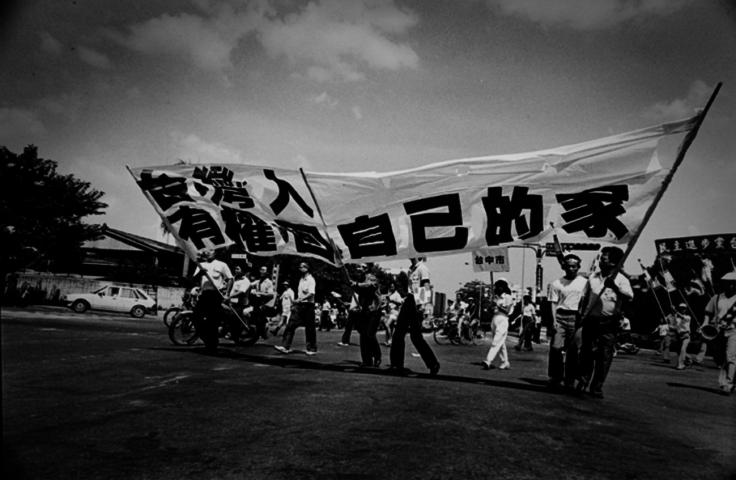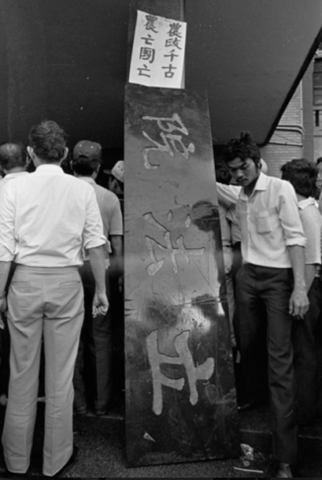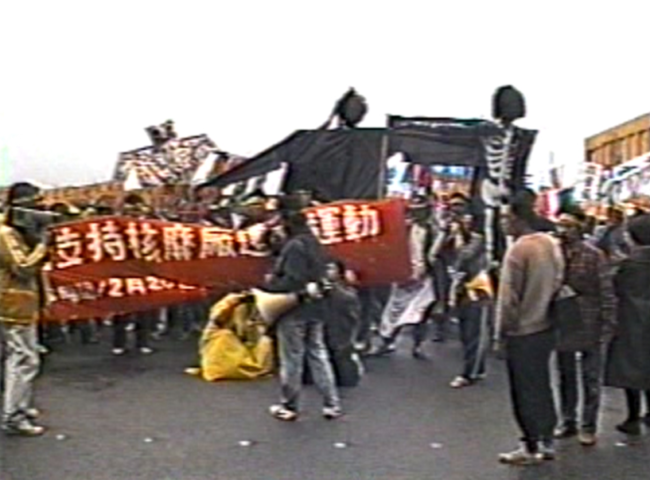




Arthub Favorite: Week 69
History’s Shadows and Light
Duration: 2017 August 29 – October 12
Venue: Taipei Cultural Center, TECO-NY
Curators: Sharleen Yu, Liu Chen-hsiang
Artists and Group: Liu Chen-hsiang, Huang Tzu-ming, Hsu Po-hsin, The Green Team
This year marks the 30th anniversary of the end of the martial law period. To commemorate, Taipei Fine Arts Museum has organized this exhibition, featuring documentary photographs of political and social movements from 1986 to 1990, a time when Taiwan was undergoing drastic transformation on many fronts.
Martial law was imposed in Taiwan on May 19, 1949 and lifted by President Chiang Ching-Kuo on July 15, 1987. Over the course of the 38-year-long martial law period, the basic human and civil rights guaranteed to the people by the Constitution, including freedoms of speech, privacy and correspondence, assembly, association, procession, petition, etc., were all abrogated.
The lifting of martial law was a major watershed in the development of Taiwanese society. It came after nearly four decades of rapid economic growth and modernization, progressive loss of the island’s international status, and a resurgence of political activism from the late 1970s.
In the 1980s, “political photography,” in coordination with Tangwai(黨外,literally non-ruling party) magazines, focused on political events and mass rallies and took a critical stance in opposition to the government. Employing a passionate visual vocabulary, it inveighed against violence on the part of the national government, achieved concrete political action, and realized the possibilities for Taiwanese photography to effect political reform. Photographs, viewed as documents in a wider sense of the word and references to particular places, events, persons, etc., also served as evidence at the level of governance and law. They were witnesses both “on the scene” and “away from the scene.” Those in power used documentary photographs to impose their public authority, and the oppressed used them to denounce oppression and injustice, to call for the righting of wrongs and for change. The camera lens is responsible only for capturing images; questions and interpretations come from the gaze of the photographer and the photographed. The exhibition “History’s Shadows and Light” ponders some of the issues that arose with the lifting of martial law, such as human rights, farmers’ and workers’ movements, and environmental protection, as documented through the photojournalism of Liu Chen-hsiang, Huang Tzu-ming and Hsu Po-hsin, and the precious documentary films of the Green Team.
Moreover, in the early 1990s, when digital cameras had yet to become commercially available, photojournalists working for then leading newspapers—China Times (中國時報), United Daily News (聯合報), Independence Morning/Evening Post(自立報系) and Tangwai magazines, including Yeh Ching-fang, Liu Chen-Hsiang, Pan Hsiao Hsia, Huang Tzu-ming, Hsu Po-hsing, Kuan Hsiao-jung, Chou Ching-hui, Tsai Ming-de, Hsu Tsun-hsu among others, still used film cameras. Every day after photographing a news event, they had to go into the darkroom to develop and fix their photos. Only after they had chosen the most suitable prints and submitted them to their editors was their work complete. As media restrictions were lifted in the 1990s, the media burgeoned, and demand for images surged. This in turn gave photographers more room to develop themselves. Thus, some photojournalists not only provided a clean and accurate record of events, but also began experimenting with visual effects – coarse granularity, high contrast or even out-of-focus or blurred images – to convey a realistic perception of the conflict and passion at the scene. One example is Yeh Ching-Fang of the China Times, who published photos of fist-fights in the legislature.
Not only did political photography, born around the lifting of martial law, embody the values of humanitarianism and social justice, as well as the passions of social movements while employing props, theater, song and dance – such as the black masks that the blacklisted Taiwanese independence activist Kuo Pei-Hung used to evade detention after returning from the United States – but it also expanded the expressive force and contagious appeal of the contemporary photographic aesthetic.
About artists
Liu Cheng-hsiang
Born in Taipei in 1963, Liu Chen-hsiang graduated from the Fine Arts Department of the Fu-hsin Trade and Arts School. In 1986, he joined the China Times Weekly. He was the photography editor of the Taipei People monthly of the Independent Newspaper Group in 1988, and was promoted to head of photography of Independent Morning Post later. He held his second solo exhibition “Before and After the Lifting of Martial Law” in the same Year. During his seven years with the Independent, he witnessed the street protests before and after the lifting of martial law with photography and left behind many precious historical images of Taiwan’s transition to democracy. From 1987, he has been taking photographs for Cloud Gate Dance Theatre and different local performing arts groups. In 1993, he left the Independent and set up his own studio. He has taken still photos for Hou Hsiao-hsiang’s Dust in the Wind, Edward Yang’s Terrorizers and all feature films by Chung Mong-hong. In 2010, he received the Wu San Lien Awards in the photography category. He has published photography books such as Taiwan Photography (2000) and In Between the Moments: Cloud Gate in a Photographer’s Memory (2009).
Huang Tzu-ming
Born in Tainan in 1960, Huang Tzu-ming graduated from the National Academy of the Arts in 1982. After completing military service in 1984, he worked as an art designer. In the following year, he joined the Management Magazine and Breakthrough Magazine of Harvard Management Services as a photographer. When the restrictions on the press were lifted in 1988, he joined the Independent Newspaper Group and worked as a photojournalist for the morning and evening post. In the same year, China Times Express was founded. He joined the China Times Group as a photojournalist and is now the head of the centre of photography of China Times. As a photojournalist for nearly 30 years, he has experienced the major political, economic, cultural and social movements in Taiwan before and after the lifting of martial law.
Hsu Po-hsin
Hsu Po-hsin was born in 1959. As a photojournalist for the Independent Evening Post from 1988 and 1995, he left behind important photographic records of the street protests in Taiwan. After years of working as a photographer for the print media, he returned to school to study sound and video documentary. In 2000, he received a master’s degree from the Graduate Institute of Studies in Documentary & Film Archiving at the Tainan National University of the Arts. He also devotes himself to making documentaries about Taiwan’s village culture, folk religion and social issues. He is now an independent documentary filmmaker and a part-time lecturer for video production at the Fu Jen Catholic University.
Green Team
Green Team (1986-90), a photographers’ group documenting social movements, was established in October 1986. Using handy electronic home video cameras, they documented the social movements of the times, and distributed the videos through informal channels to spread the messages of social movements, so as to subvert the official news of the three TV channels. They were a more representative “minority media” outlet before and after the lifting of martial law.
The period from 1986 to 1990 was the period when Taiwanese actively took part in protests for democracy, human rights, fairness and justice. The pro-democracy movements ran against the martial law imposed by the government. As social movements thrived, there were all sorts of self-help activities organized by environmentalists, the indigenous people, students, army veterans, peasants and workers. During the four-year period, Green Team made 1500 videos, creating 3000 hours of precious film images of the efforts made by Taiwanese.
For more details, please click here.